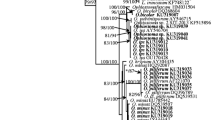Abstract
Bacteria cause deformation and blemishing in pearls, and we investigate this relationship. We examined pearls derived from Pinctada margaritifera, Pinctada maxima, and Pinctada fucata, and determined the location of bacteria using histopathological and immunohistochemical techniques and 16S ribosomal RNA (rRNA) sequence analyses. The most remarkable change was the inflammatory reaction located between the pearl nucleus and the nacreous layer, composed of hemocytic infiltration with melanization, periostracum, and fibrous aragonite-like structures. These anomalous changes were limited to abnormal sites, and such inflammatory reaction sites are a major factor in the formation of pearl abnormalities. Bacteria were detected from the inflammatory sites and are suspected as the causative agent. Most of these bacteria were anaerobic.



Similar content being viewed by others
Reference
Wada K (1999) Science of the pearl. Shinju Shinbunsha, Tokyo (in Japanese)
Taylor J, Strack E (2008) Pearl production. In: Southgate PC, Lucas L (eds) The pearl oyster. Elsevier, Oxford, pp 273–302
Uemoto H (1961) Physiological studies on nuclear insertion operation of pearl oyster I-III. Bull Natl Pearl Res Lab 6:619–635 (in Japanese)
Uemoto H (1962) Physiological studies on the nuclear insertion operation of pearl oyster IV. On control of physiological condition after operation. Bull Natl Pearl Res Lab 8:896–903 (in Japanese)
Atsumi T, Ishikawa T, Inoue N, Ishibasi R, Aoki H, Nishikawa H, Kamiya N, Komaru A (2011) Improvement of the production of high-quality pearls by keeping post-operative pearl oysters Pinctada fucata in low-salinity seawater. Nippon Suisan Gakkaishi 77:68–74 (in Japanese)
Hasuo M (1959) The influence on quality of cultured pearls caused by the extent of friction on the mantle piece of pearl oyster Pinctada martensii (Dunker) on pearl formation. Bull Natl Pearl Res Lab 5:494–498 (in Japanese)
Aoki S (1959) Some experiments on the nuclear insertion in the pearl-culture of oyster (Pinctada fucata martensii) IV. On the quality and shape of the cultured pearl in relation to the site of the pearl-formation. Bull Natl Pearl Res Lab 5:516–540
Norton J, Lucas J, Turner I, Mayer R (2000) Approaches to improve cultured pearl formation in Pinctada margaritifera through use of relaxation, antiseptic application and incision closure during bead insertion. Aquaculture 184:1–17
Aoki H, Hayawaki Y, Yamamoto M, Ito T, Takeuchi A, Deguchi A, Koga F, Nishikawa K, Nomura K, Oyama K, Yamashita M, Iwaki H (2007) Comparison Japanese and hybrid of pearl oyster Pinctada fucata in characteristic of farming and pearl quality. Zenshinren Gijutsukenkyukai Kaiho 21:1–5 (in Japanese)
Miyauchi I (1962) The study on the pearl quality improvement. Suisan Zoshoku 9:207–214 (in Japanese)
Taniguchi T, Zenitani B (1963) On the use of antibiotics for operation of pearl mother-shells and its effect on the quality of pearl produced. Bull Fac Fish Nagasaki Univ 14:30–34 (in Japanese)
Miyashita T, Takagi R (2011) Tyrosinase causes the blue shade of an abnormal pearl. J Molluscan Stud 77:312–314
Galkiewicz JP, Kellogg CA (2008) Cross-kingdom amplification using bacteria-specific primers: complications for studies of coral microbial ecology. Appl Environ Microbiol 74:7828–7831
Dauphin Y, Ball AD, Cotte M, Cuif J, Meibom A, Salomé M, Susini J, Williams CT (2008) Structure and composition of the nacre-prisms transition in the shell of Pinctada margaritifera (Mollusca, Bivalvia). Anal Bioanal Chem 390:1659–1669
Lillie RD, Fullmer HM (1976) Endogenous pigments. In: Histopathologic technic and practical histochemistry. McGraw-Hill Inc., New York, pp 485–527
Aoki S (1966) Comparative histological observations on the pearl-sac tissues forming nacreous, prismatic and periostracal pearls. Nippon Suisan Gakkaishi 32:1–10
Machii A (1959) Studies on the histology of the pearl-sac IV. On the pearl-sac tissue of so-called “kokuhan” (black spotted). Bull Natl Pearl Res Lab 5:407–410
Paillard C, Korsnes K, Chevalier PL, Boulay CL, Harkestad L, Eriksen AG, Willassen E, Bergh Ø, Bovo C, Skår C, Mortensen S (2008) Vibrio tapetis-like strain isolated from introduced Manila clams Ruditapes philippinarum showing symptoms of brown ring disease in Norway. Dis Aquat Organ 81:153–161
Paillard C (2004) A short-review of brown ring disease, a vibriosis affecting clams, Ruditapes philippinarum and Ruditapes decussatus. Aquat Living Resour 17:467–475
Renwrantz L, Schmalmack W, Redel R (1996) Conversion of phenoloxidase and peroxidase indicators in individual haemocytes of Mytilus edulis specimens and isolation of phenoloxidase from haemocyte extract. J Comp Physiol B 165:647–658
Luna-González A, Maeda-Martίnez AN, Vargas-Albores F, Ascencio-Valle F, Robles-Mungaray M (2003) Phenoloxidase activity in larval and juvenile homogenates and adult plasma and haemocytes of bivalve molluscs. Fish Shellfish Immunol 15:275–282
Yano I (1975) An acetone soluble pigment in dark brown matter formed in both the nacres of the shell and the pearl of the pearl oyster, Pinctada fucata (Gould). Bull Natl Pearl Res Lab 19:2149–2151 (in Japanese)
Author information
Authors and Affiliations
Corresponding author
Rights and permissions
About this article
Cite this article
Ogimura, T., Futami, K., Katagiri, T. et al. Deformation and blemishing of pearls caused by bacteria. Fish Sci 78, 1255–1262 (2012). https://doi.org/10.1007/s12562-012-0545-x
Received:
Accepted:
Published:
Issue Date:
DOI: https://doi.org/10.1007/s12562-012-0545-x




